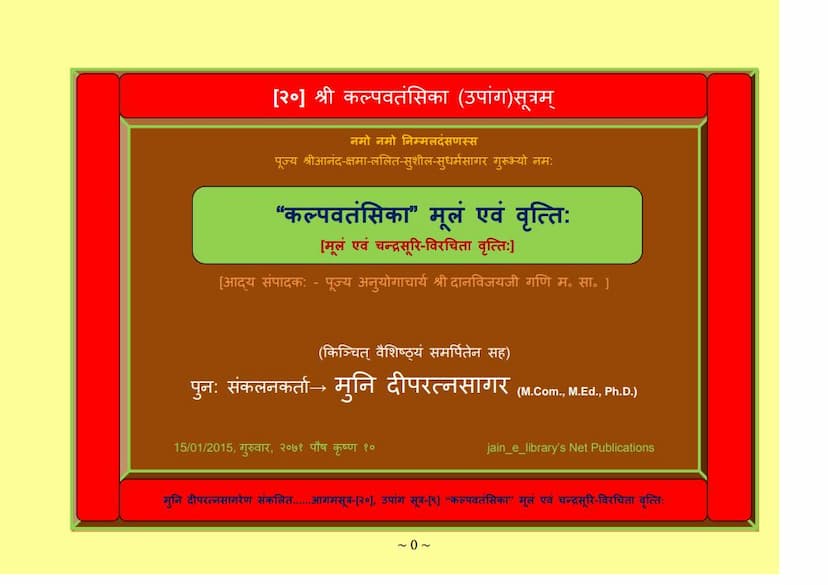Aagam 20 KALPAVATANSIKAA Moolam Evam Vrutti
Added to library: September 1, 2025
Loading image...

Summary
This document is a scanned copy of a Jain text titled "Kalpavataṃsikā" (कल्पवतंसिका), which is an Upāṅga Sūtra (उपाङ्ग सूत्र) of the Agamas. The work is presented with its original text (Mūlaṃ) and a commentary (Vṛttiḥ) attributed to Candrasūri. The present publication is compiled and edited by Muni Dīpratnasāgar, with revisions and editorial contributions from Anuyogāchārya Shri Dān vijayji Gaṇi.
Here's a breakdown of the provided pages and their content:
Page 1:
- Title: "Kalpavataṃsikā" (कल्पवतंसिका) - Upāṅga Sūtra [20].
- Author/Editors:
- Mūlam (Original Text): Agam Sutra [20], Upāṅga Sutra [5] "Kalpavataṃsikā" Mūlam evam Candrasūri Virachita Vṛttiḥ.
- Compiled by: Muni Dīpratnasāgar (M.Com., M.Ed., Ph.D.).
- Edited by: Pujya Anuyogāchārya Shri Dān vijayji Gaṇi M. Sa.
- Publisher: Deepratnasagar.
- Date: January 15, 2015.
- Acknowledgments: Salutations to Pujya Anand-kshamā-lalit-sushīl-sudharma sāgar Gurus.
Page 2:
- Publication Details:
- This is a reprint of a publication originally titled "Nirayāvalikā" from 1922 (Vikram Samvat 1978) by the Āgamoḍaya Samiti, with Pujya Dānvijayji Gaṇi as the editor. That initial publication included five Upāṅgas: "Nirayāvalikā, Kalpavataṃsikā, Puṣpitā, Puṣpacūlikā, and Vṛṣṇidaśā."
- The page laments that later publications of this text by other revered figures did not add new content but merely re-scanned and reprinted the original, sometimes omitting the original editor's and publisher's names while attributing the work to themselves or their predecessors.
- Muni Dīpratnasāgar's Rationale:
- The current effort is an attempt to serve the Agamas, building upon previous extensive publications of the 45 Āgamas.
- This specific publication is a scanned version of a respected ancient edition.
- A special format has been created where the original edited text is placed in the middle, with the Agama name, chapter, and verse numbers clearly marked at the top of each page for ease of reading.
- A "Dīp Anukram" (Deep Index) is provided on the left side, facilitating navigation across various publications by the same publisher in different languages.
- Differentiating between verses (Gāthā) and prose (Sūtra) is indicated by specific markers (|| || or "gāthā" for verses, and [-] for prose).
- Index: An index of studies and page numbers is included for easy access to specific topics.
- Footnotes: Footnotes are provided at the bottom of many pages to clarify content, correct printing errors, or address numbering discrepancies from the original text.
- Publication Goal: The current release is an "Internet Publication" by jain_e_library.org for wider reach, with plans for a printed version in the future.
Page 3:
- Table of Contents (Viṣayānu krama):
- Lists the studies (Adhyayana) within the Kalpavataṃsikā.
- Study [1] is "Padma" (पद्म) on page 004.
- Study [2] is "Mahāpadma" (महापद्म) on page 005.
- Studies [3-10] are listed as "Bhadra, Subhadra, etc." starting on page 005.
Pages 4-8 (Content of the Text): These pages contain the actual Jain text of the Kalpavataṃsikā, likely in its original Prakrit with the commentary.
- Page 4: Shows the beginning of Study 1 (Adhyayana 1), named "Padma". It mentions the 20 Agamas and the 9 Upāṅga Sūtras, with Kalpavataṃsikā being the 9th. The text describes the setting in Champā city, King Kūṇika, Queen Padmāvatī, and Prince Padma, tracing his lineage and his renunciation to become a monk.
- Page 5: Continues Study 1, detailing Padma's ascetic practices and his eventual rebirth as a deity in the Saudharma heaven for two sāgaropama lifetimes. It then transitions to Study 2 (Adhyayana 2), named "Mahāpadma," starting with a similar narrative of Prince Mahāpadma and his rebirth in the Īśāna heaven.
- Page 6: Presents a Gāthā (verse) discussing the duration of vows and lifespans of subsequent individuals mentioned in the text. The commentary explains these details, linking them to their eventual rebirths in different heavens and their ultimate liberation in Mahāvideha. It continues with Study 3, 4, and mentions the subsequent studies.
- Page 7: Continues the explanation of Studies 5 through 8, detailing the individuals, their vow durations (three years, two years), their rebirths in higher heavens (Brahmaloka, Mahāśukra, Sahasrāra), and their lifespans in Sāgaropama. It mentions the concept of them attaining liberation in Mahāvideha.
- Page 8: Concludes the summary of the studies, detailing Studies 9 and 10. It mentions the individuals' vow durations (two years), their rebirths in the Prāṇata and Ac Yudha heavens, their lifespans, and their eventual liberation. The page marks the end of the second section (Dvitīya Varga) and the Kalpavataṃsikā itself, noting there are ten studies in total.
Page 9:
- Final Acknowledgment: Reiteration of salutations and confirmation of the completion of the "Kalpavataṃsikā: Mūlam evam Vṛttiḥ" compilation by Muni Dīpratnasāgar, based on the revised and edited version by Pujya Ācārya Shri Dānvijayji Gaṇi. It also confirms this is a Net Publication of jain_e_library.
In essence, the "Kalpavataṃsikā" is a Jain scripture that:
- Focuses on the lives and spiritual journeys of individuals, often princes and their families.
- Details their adherence to vows, ascetic practices, and subsequent rebirths as celestial beings (devas) in various heavens.
- Chronicles their lifespans in the heavens and their eventual liberation (moksha) in the sacred land of Mahāvideha.
- Is presented with its original text and a commentary by Candrasūri, compiled and edited with scholarly rigor by Muni Dīpratnasāgar and Shri Dān vijayji Gaṇi.
- This specific publication aims to make this important text accessible through digital means, preserving its traditional scholarship while improving its readability and navigation.